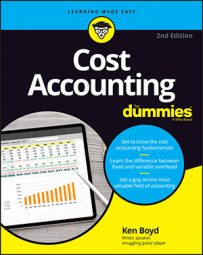In cost accounting, joint costs are production costs incurred in creating two (or more) products. There are several important reasons why you spend time figuring and allocating joint costs:
Financial reporting: Joint costs need to be computed and allocated for inventory and cost of goods sold. Financial accounting is the process of creating financial reports for external users (for example, shareholders, creditors, or regulators). Of course, there are standards of financial reporting — rules of the road for explaining financial results — and many books have been written about them.
Product pricing: Joint costs are used to compute total product costs. Product costs are then used to determine a profit and a sale price. You need to calculate joint costs to calculate inventoriable costs. Those costs are attached to inventory and expensed when the product is sold. So you need joint costs to calculate inventory values and the cost of goods sold. This information ends up in your financial reports, too.
It’s a mantra you may grow tired of hearing: You need total product costs to decide on a profit level and figure out a sale price. If you have joint production, you need the joint costs to compute total product costs.
Contracts: Joint costs are part of cost reimbursement under contracts. Under many contracts, you need to justify your costs and document them to receive reimbursement. Essentially, you’re proving that your spending met the guidelines in the contract. If you have joint costs, they need to be part of this process.
Insurance settlements: Insurance settlements for damage claims include joint costs. If you file an insurance claim regarding damaged assets, you need to document each asset’s value. Say you produce inventory using a joint production process. And say some of that inventory was damaged when your warehouse was hit by a storm. To justify the inventory cost for your insurance claim, you need details on the joint costs in that inventory.
Regulated products: A regulated product or service may require joint cost allocations to compute a price. Some industry prices are set and controlled by federal or state regulation. Utility companies are the best example. Because it’s a process of justifying costs, you need to provide your total costs (including joint costs) to the regulator.
Litigation: Litigation documentation and support may require joint cost allocations. Unfortunately, litigation is a cost of doing business. Every company, to some extent, has to deal with litigation. Whether your company is initiating a legal action or defending itself against an action, you need good documentation.
Often, the issue in corporate litigation is a product or service. The value of the product must be determined so that the court knows the dollar amount in dispute. If you use joint production, you need to include the joint costs in your total.

